
Under osteochondrosis of the cervical column means a dystrophic degenerative pathology which affects the discs located between the vertebrae.The disease is diagnosed mainly in people aged 30 to 50, but can occur at a different age.It is important to identify the pathology in a timely manner and to carry out an appropriate treatment.If this is not done, the disease will pass to a new stage of development, which can lead to the need for surgery to replace the intervertebral discs with prostheses.
Causes of the disease
Neck osteochondrosis occurs for the following reasons:
- sedentary lifestyle;
- obesity;
- bad nutrition;
- Lesions of the spine previously suffered, especially if segments of the cervical region were damaged;
- excessive physical activity;
- Stay in the same installation with an inclined head for a long period - for this reason, the pathology is often diagnosed in desktop employees working on the computer;
- genetic predisposition;
- Unstable emotional context;
- neck hypothermia;
- autoimmune pathologies, following the development of which the cartilage fabric is injured;
- Incorrect structure of the spine diagnosed from birth.
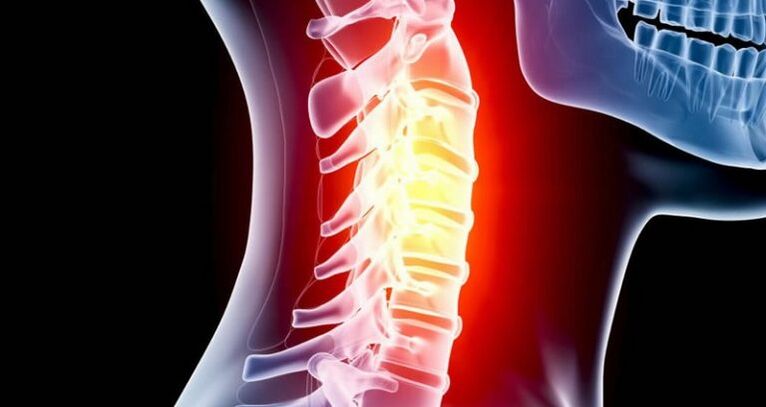
The development of osteochondrosis in the cervical region is also facilitated by a genetic predisposition.
Degree and type of disease
Cervical osteochondosis goes through several stages of development, each presents a certain symptom:
- The disease of the first step.It is the very beginning of the development of pathology.The patient suffers from pain in the affected area, which intensifies during movement.This step is also characterized by the tension of the back muscles and rapid fatigue.Pathology at this stage does not need therapy.The disease can be eliminated using the correct electricity system, exercise therapy and the abandonment of harmful dependencies.
- The second stage of pathology.The disease progresses, affecting intervertebral discs.Their height decreases, which leads to a reduction in the distance between the vertebrae and the nerves.As a result, pain syndrome becomes more pronounced.He intensifies when his head moves and gives it to the shoulders or hands.Such symptoms also appear - inattention, fatigue, pain in the head area.For the treatment of pathology, drugs are prescribed.
- The third degree of the disease.The hernias of the intervertebral discs begin to form.Pain syndrome is improved.The pain is located in the neck and head and gives the shoulders and hands.The dizziness appears, the patient is weak.The neck loses mobility.A particularly acute membership is felt in the morning.
- The fourth stage of the disease.The intervertebral discs are completely destroyed.Their place is occupied by connective tissue.The pain is intensifying and does not disappear even during sleep, the neck almost completely turns to turn, dizziness becomes more frequent, the patient loses the coordination of movements and there is noise in the ears.
Clinical image
Schop osteochondosis manifests in different ways, according to the lesion of specific segments.However, there are general symptoms characteristic of the injury of the department's vertebrae:
- Pain syndrome in the head, giving to the chest, arms, shoulders;
- vision of vision and hearing;
- Crunch when moving the neck;
- numbness of the fingers of the upper limbs and the end of the language;
- weakness in the muscles of the arms, legs;
- Increase in blood pressure.
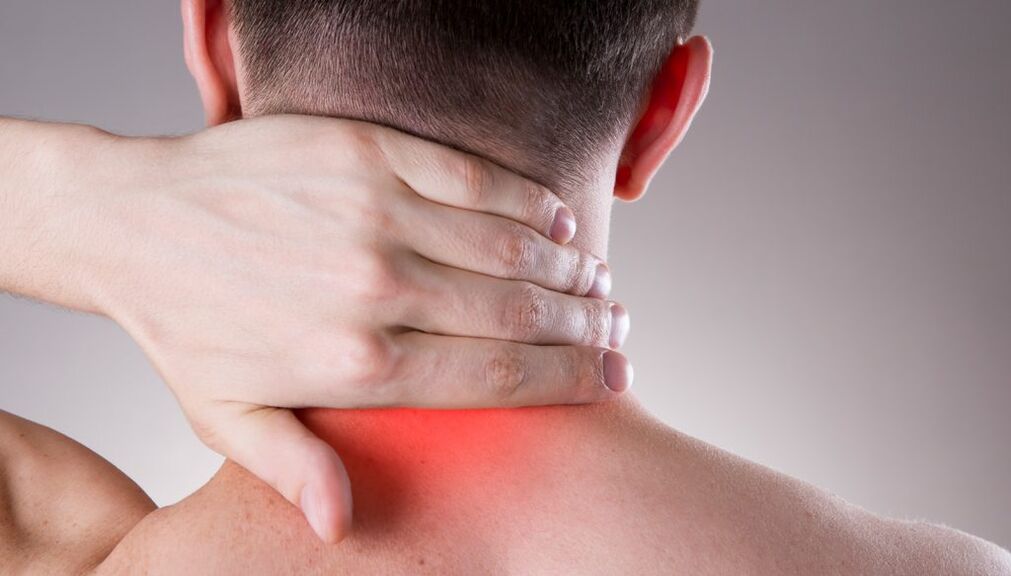
Pathology is also characterized by certain syndromes, each of which is discussed in detail below.
Radio syndromes
With cervical osteochondosis, the nerves are pinched, as a result of which fluid pain syndrome occurs.The pain gives shoulders and hands.The following symptoms also appear:
- Small pimples at the base of the hair on the epidermis, which, in ordinary people, call goosebumps;
- skin tingling;
- loss of elasticity and elasticity of the epidermis;
- Swelling of soft tissues;
- Pallor of the skin.
Vail artery syndrome
Characterized by the following symptoms:
- Burning or pulsating, constant or paroxysmal pain, which intensifies when the head moves or remains in a pose for a long time;
- dizzy and fainting;
- nausea;
- Loss of coordination of the movement;
- noise in the ears and the deterioration of listeners;
- pain in the eyes;
- Vision of vision.
Cervical migraine syndrome
If osteochondrosis of the cervical spine occurs, this can lead to the appearance of cervical migraine syndrome.In this case, the nodes of the sympathetic column are irritated.As a result, there are problems with brain vessels and blood circulation.This leads to a regular increase in blood pressure characterized by the following symptoms:
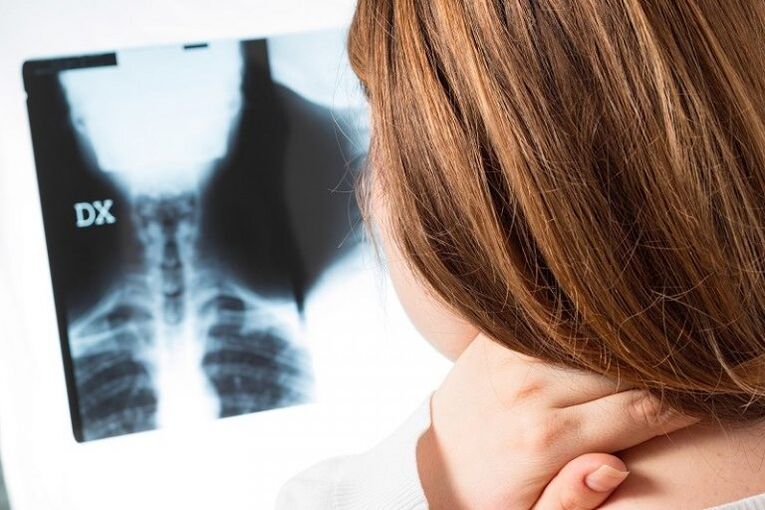
- heart rate;
- noise and ringing in the ears;
- The audience gets worse.
Hypertension syndrome
If osteochondrosis of the cervical column has caused the occurrence of hypertension syndrome, the patient increases intracranial pressure.Such symptoms appear:
- brilliant pain;
- nausea with vomiting;
- increase in body temperature.
When examining the blood, an increase in the rate of regulation of erythrocytes will be indicated.
Diagnosis
To diagnose pathology, instrumental research and laboratory tests are prescribed.
Instrumental
If signs of osteochondrosis in the cervical region occur, it is recommended to consult a doctor.Only a specialist can diagnose a pathology.For this, a professional prescribed such an instrumental research:
- X -Ray.Such a study is rarely prescribed, because it does not give a complete idea of the development of pathology, in particular on the 4th stage of the disease.
- Ct. It helps to identify the changes that have occurred in the vertebrae.However, this study cannot determine the presence of hernias between the segments, which means that it will not say anything about their shape and their size.
- MRI.It helps to identify any violation of the spine, including intervertebral hernias.
- Duplex ultrasound.Such a study is prescribed in the event of suspicion of blood circulation problems on the vessels of the column of the neck.Duplex ultrasound will show the presence of blood circulation disorders, as well as obstacles that interfere with the normal blood course.
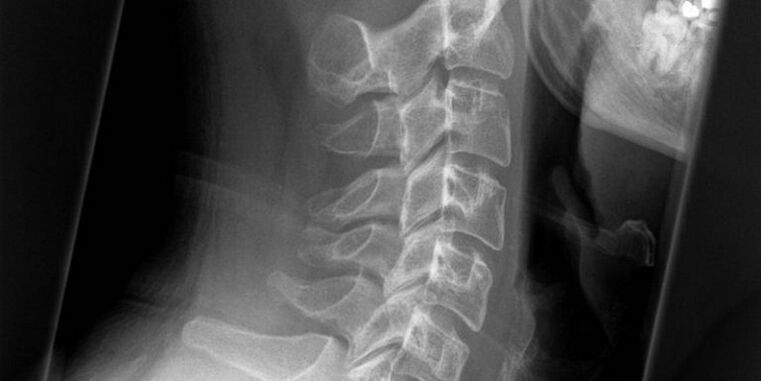
Laboratory
With cervical osteochondosis, a general and biochemical blood test is also prescribed.Such studies do not help diagnose pathology, but the doctor can determine the patient's state of health and obtain information on the inflammatory process.
Traditional treatment
The treatment of cervical osteochondrosis of the spine is prescribed by a doctor.Therapy is very difficult and takes a long time.Treatment aims to inhibit the development of the disease and eliminate symptoms.For this, drugs, physiotherapy, exercise therapy and other procedures are prescribed.If conservative treatment has not given the desired result, surgery is carried out.
First aid for exacerbations
First aid must be provided to the patient if he feels serious and unbearable pain and if his neck is stuck in a position.It is recommended to immediately call an ambulance team, and before the arrival of specialists, you must act as follows:
- Rub an analgesic ointment in a painful stain.
- Give the patient an analgesic.
- To make a compress with camphor - this will help restore joint mobility, improve blood microcirculation and relieve pain.
Before the arrival of doctors is impossible:
- Try to make a patient massage.Bad movement will make the situation worsen.
- Rub the ointment of warming in the injured segment.If pathology is accompanied by an inflammatory process, the use of such a tool will result in deterioration of the situation.
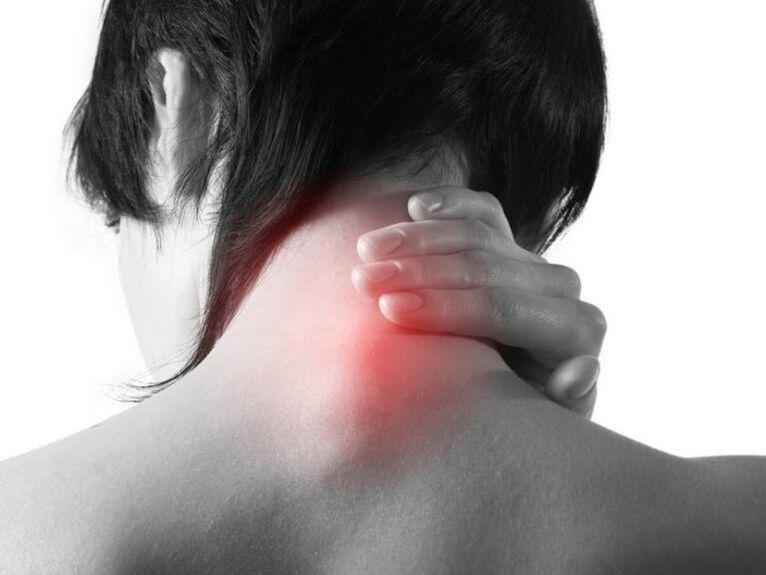
Emergency specialists to solve the problem on site or take the patient to the hospital.Treatment of cervical osteochondosis will be prescribed after diagnostic measures.Usually, after first aid, the patient returned home in order to undergo ambulatory therapy.
Medicine
The treatment of osteochondrosis of the cervical column is based on the use of these drugs:
- Non-steroidal agents with anti-inflammatory properties.These drugs get rid of the symptoms of the disease.The funds also stop the inflammatory process and save the traumatic nerve of the swelling.The tablets are consumed 2-3 times a day after eating.The duration of treatment is 2 to 3 weeks.
- Musorelaxants.They get rid of muscle spasms and muscle tissue in the tone.
- Corticosteroids.These are hormonal drugs.The means are only prescribed if other drugs have proven their ineffectiveness.Medicines have a large number of contraindications and side effects, so you can use them for therapy only as prescribed by a doctor.
- Diuretics.Rise the body from excess liquid.Thanks to this, drugs contribute to the elimination of soft tissue swelling on the site of the inflammatory process.
- Blocks.Usually doctors prescribe undercutaneous or intramuscular means.Drugs are administered in several points in the injured vertebrae area.This allows you to stop pain syndrome.
- Chondroprotectors.They stop the development of pathology and contribute to the restoration of injured cartilage.
- B vitamins of B. improve metabolism and neuromuscular conductivity.
Surgical
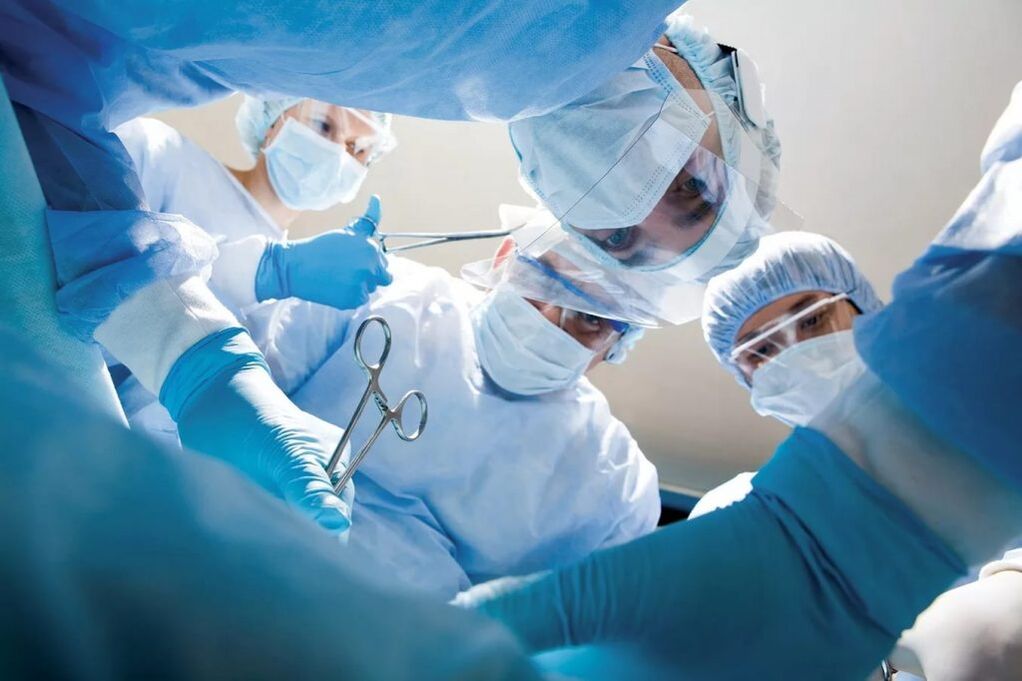
Surgical intervention is prescribed at the last stages of the development of the disease and only with the ineffectiveness of conservative therapy.The evaluation of the treatment result is carried out in six months.In the absence of an effect, surgery is carried out.The operation may be prescribed earlier if unbearable pains occur or if membership of the members has occurred.
Gymnastics for the neck
The treatment of house pathology is based not only on the use of drugs, but also on the performance of special exercises.Exercise therapy is prescribed by a doctor.The classes are only carried out during the period of remission of the disease.To get rid of the intervertebral pliers, it is recommended to perform such exercises:
- Lying on the belly by emphasizing the ground, the uprising of the head and the body is carried out.The exercise is repeated 2-3 times with a fixing at the top of 2 to 3 minutes.
- Lying on the stomach, they make rehearsals in both, touching the ground of the soil.The number of rehearsals is 7 in each direction.
- Sitting on the ground, lean towards the chest chin, after which they lean backwards, throwing his head back.The exercise is carried out 10 to 15 times.
- Sitting, put their palms on the forehead and press.Then press the head in the palm of your hand.The number of rehearsals is 2-3.
- By staying, they first turn their heads in one, then in the other direction.The number of rehearsals is 10.
Physiotherapy
To get rid of cervical osteochondrosis, physiotherapeutic procedures are also prescribed.Such treatment helps get rid of the symptoms of the disease and helps restore injured cartilage.Usually the following procedures are prescribed:
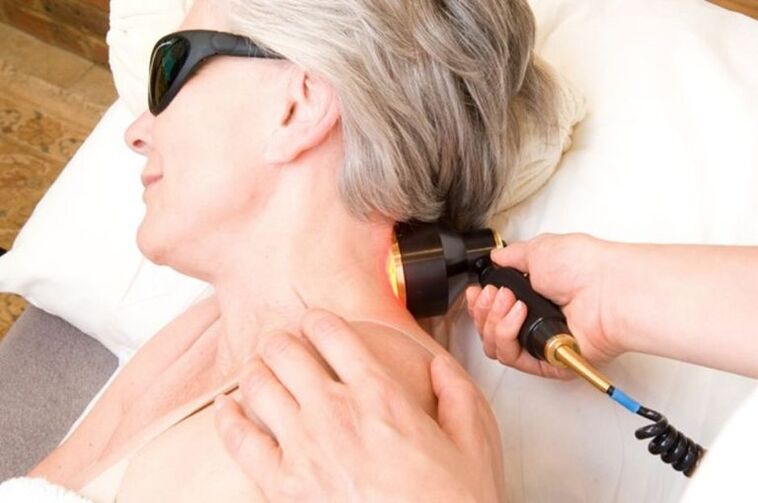
- Laser therapy.The essence of the method is the effect of laser on the affected areas of the spine.This improves blood microcirculation and stops the inflammatory process.
- Electrophoresis.The procedure is carried out with pain relievers.The essence of the method is the effect on the injured parts of the body with a small electric current to pass ions with drugs to the damaged area of the spine.
- Ultrasound.The procedure improves metabolic processes occurring in cells, stops pain syndrome and stops the inflammatory process.
- Magnetotherapy.Relins swelling of soft tissues and eliminates pain syndrome.
In order to increase the efficiency of therapy, alternative treatment methods can also be prescribed:
- Massage of the cervical-brother area;
- Manual therapy;
- acupuncture and other procedures.
Nutrition
Treatment of cervical osteochondosis will be ineffective if you do not comply with certain nutritional rules.The diet will help:
- Avoid the occurrence of a lack of beneficial substances, as vitamins and minerals are involved in the metabolic processes of intervertebral disc cells;
- normalize body weight, which will reduce the load on the spine;
- To minimize the probability of sclerotic changes in blood vessels, thereby reducing the risk of altered blood supply to the brain.

The basic principles of good nutrition for cervical osteochondrosis:
- The diet must be balanced with the daily dose of kilocalories-1200-1500;
- Food is taken in small portions 5 to 6 times a day;
- Observe the alcohol consumption diet to prevent dehydration of tissues from intervertebral discs - at least 1.5 liters of liquid is drunk per day;
- Limit the consumption of salt, because it keeps liquid in the body, causing the appearance of swelling of the tissues;
- limit the consumption of starch and flour products;
- Exclude fat, fries, spicy, fumes from the diet;
- Refuse to use alcohol and sweet soft drinks, as well as store juices in boxes;
- Fresh vegetables and fruit, lean meat, lean fish varieties, cereals, milk and bitter dairy products with a minimum mass fraction of the fat content are introduced into the menu.
Tibetan applicator
Even with cervical osteochondosis, doctors recommend using a Tibetan applicator to improve the condition. It is a device with plastic tips, which affect the epidermis.The patient applies the applicator to the problematic zone and occupies a position of lie.Consequently, the epidermis receptors participating in the physiological processes of the body are bored.
It is a device with plastic tips, which affect the epidermis.The patient applies the applicator to the problematic zone and occupies a position of lie.Consequently, the epidermis receptors participating in the physiological processes of the body are bored.
This procedure gives the following result:
- The management towards sleep is standardized, the quality and duration of the night rest is improving;
- Pain syndrome stops;
- Blood microcirculation improves;
- The mobility of the joints is restored;
- The performance is increased.
The Tibetan applicator has contraindications:
- Pathology of the epidermis;
- diseases caused by infections;
- vascular diseases;
- Oncological pathologies of malignant nature.
You can only use the device after consulting a specialist.
Popular treatment
The use of non -traditional medicine is another way of treating cervical osteochondosis.These drugs are used only with the permission of the doctor.Public medicine increases the effectiveness of medication.For the treatment of the disease, it is impossible to use as independent drugs.You will find below recipes for the preparation of non-traditional medicine for the treatment of osteochondrosis.
Cabbage compression
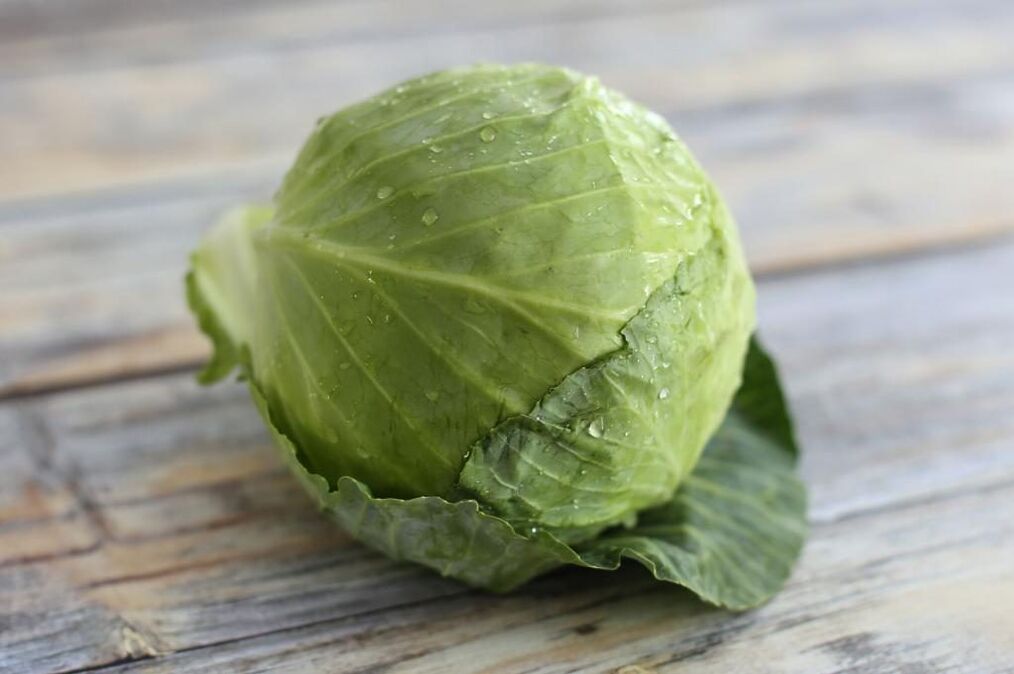
A fresh cabbage sheet is slightly beaten with a hammer to soften.After that, it is fixed on the area of the problem and isolated.The compress is kept for several hours.The procedure is carried out daily.Instead of a cabbage sheet, you can use horseradish leaves.
Hop -based ointment
The necessary components:
- Cons of Hops cut in powder - 1 large spoon;
- Butter - 1 large spoon.
The products are connected and mixed.The resulting composition is treated with the affected area and fixed the insulation bandage.The compress is maintained from a few minutes to several hours.The procedure is carried out daily.The ointment is stored in the refrigerator.
Honey compression
Necessary ingredients:
- Grated raw potatoes - 1 large spoon;
- Honey - 1 Large spoon.
The components are mixed and placed in a piece of gauze.The compress is fixed on the problem area for 20 minutes.The procedure is carried out once every 7 days.
Disease prevention
The following preventive measures will help avoid the occurrence of pathology:
- Direct an active lifestyle - playing sports, swimming better;
- Enrich the diet with products containing magnesium and calcium;
- Several times a day, make a hot-up during the session work;
- Use orthopedic bedding for night rest;
- Take a hot shower every day for 10 minutes;
- abandon excessive physical effort;
- Visit a doctor regularly and process pathologies in a timely manner, which can cause the occurrence of cervical osteochondosis.
What is dangerous osteochondrosis of the neck
The main danger of the disease is that the lack of therapy in a timely and qualified manner can cause a complete immobilization of the joints, which leads to a handicap.In addition, the pinch of the cervical vertebrae negatively affects blood intake to the brain.As a result, headache and other appropriate diseases occur.For this reason, you cannot ignore pathology.
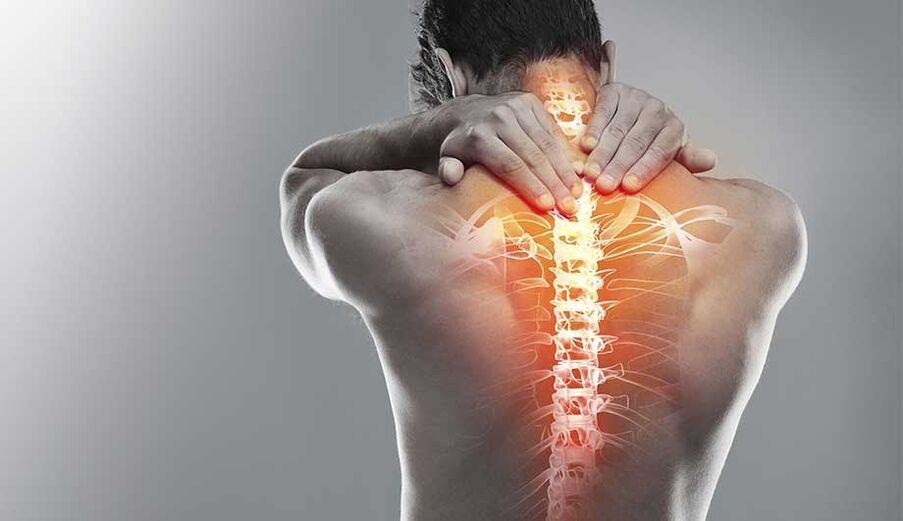
Cervical osteochondosis is a pathology of the spine, which in the absence of qualified therapy in a timely manner leads to sad consequences.To prevent this from happening, it is recommended to consult a doctor after the first symptoms of the disease.














































